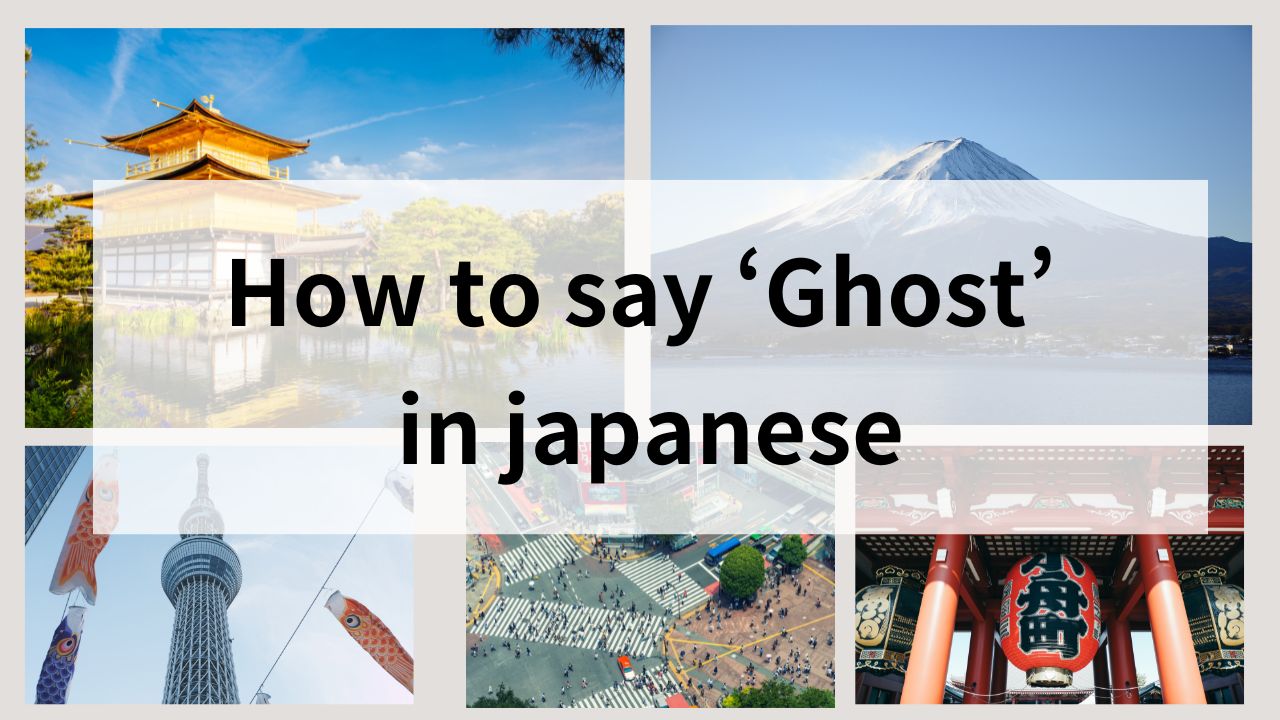Are you curious about how to say “ghost” in Japanese? The concept of ghosts has a rich history in Japanese culture, encompassing a wide range of beliefs, folklore, and supernatural elements. This guide will explore the Japanese word for “ghost,” its cultural significance, and practical applications.
How Do You Say “Ghost” in Japanese?
The Japanese word for “ghost” is 幽霊 (yūrei). This term is widely recognized and used in both casual conversation and formal contexts. The concept of yūrei is deeply rooted in Japanese folklore and spirituality, often associated with the souls of the deceased who have not found peace.
The Japanese Word for Ghost: Yūrei (幽霊)
“Yūrei” is a term used to describe various types of ghosts and spirits in Japanese culture. For example:
- 幽霊屋敷 (Yūrei yashiki): “Haunted house.”
- 幽霊映画 (Yūrei eiga): “Ghost movie.”
- 幽霊船 (Yūrei sen): “Ghost ship.”
Kanji for Ghost: 幽霊
The kanji for ghost, 幽霊, consists of two characters. The first character, 幽 (yū), conveys a sense of darkness or hiddenness, while the second character, 霊 (rei), means spirit or soul. Together, they represent the idea of a ghostly presence.
This kanji combination is commonly seen in literature, media, and discussions about the supernatural, reflecting the cultural significance of ghosts in Japan.
Does “Ghost” Work in Japanese?
The English word “ghost” is generally understood in Japan, especially among younger generations or those familiar with horror films and modern culture. However, its recognition might be less universal among older individuals or in more traditional contexts. A 5-point scale rates its comprehension as:
- Rating: 4 – Generally understood (60-80% of people)
If clarity is crucial, using the Japanese term 幽霊 (Yūrei) is recommended. While “ghost” may be understood in certain contexts, “yūrei” ensures effective communication.
The Cultural Significance of Ghosts in Japan
Ghosts hold a special place in Japanese culture, symbolizing the souls of the deceased who may have unfinished business or unresolved feelings. Traditional beliefs about yūrei influence various aspects of Japanese life, including festivals, rituals, and the arts.
Yūrei as a Symbol of Unrest
In Japanese folklore, yūrei are often depicted as spirits of individuals who died tragically or violently, leading to their unrest. Rituals such as Obon, a festival to honor the spirits of ancestors, are essential for helping these spirits find peace.
Yūrei in Folklore and Mythology
Yūrei appear frequently in Japanese folklore, literature, and theater, representing themes of love, vengeance, and sorrow. They are often depicted with long, unkempt hair and white funeral garments, embodying the traditional image of a ghost.
In addition to traditional stories, yūrei have a significant presence in modern Japanese pop culture, including horror films, anime, and manga, showcasing the enduring fascination with ghostly tales.
- The Ring: The film features a vengeful ghost, Sadako, whose tragic backstory is central to the plot.
- Ringu: The original Japanese horror film that popularized the yūrei trope in cinema, emphasizing themes of anguish and revenge.
- Noroi: A found-footage horror film that incorporates traditional beliefs about yūrei and their impact on the living.
- Yokai Watch: This popular series features various yōkai (supernatural creatures), including ghostly figures that represent yūrei.
- Fate/Grand Order: Characters in this game often draw on historical figures and lore, including yūrei-inspired heroes and spirits.
These examples illustrate how yūrei continue to symbolize unresolved emotions and supernatural elements, bridging traditional beliefs and modern storytelling.
Differences Between Ghosts in Japan and Overseas
Yes, there can be subtle differences in how “ghost” is perceived in Japan versus Western cultures. In Japan, yūrei are often viewed as spirits with specific ties to their earthly lives, while Western ghosts may be interpreted more broadly as any spirit of the dead. Understanding these cultural nuances can help avoid confusion, especially when discussing supernatural themes in creative or professional settings.
Practical Applications of “Ghost” in Japanese
Learning how “ghost” is used in Japanese can help you navigate conversations, understand idioms, and recognize its presence in Japanese culture.
Talking About Ghosts in Daily Conversation
Here are some examples of how “yūrei” is used in everyday conversation:
- 幽霊が見えます (Yūrei ga miemasu): “I can see a ghost.”
- 幽霊の話 (Yūrei no hanashi): “A story about ghosts.”
Ghost-Related Idioms or Expressions
While there are relatively few specific idioms involving “yūrei,” the concept of ghosts is often associated with fear, mystery, and the supernatural in Japanese culture. Here are some idioms, phrases, and expressions that incorporate or symbolize ghosts:
- 幽霊屋敷 (Yūrei yashiki): “Haunted house,” a common phrase used to describe places believed to be inhabited by spirits.
- 幽霊のように (Yūrei no yō ni): Literally “like a ghost,” used to describe someone who is very quiet or elusive.
- 幽霊を見た (Yūrei o mita): “I saw a ghost,” often used in stories or anecdotes.
- 幽霊船 (Yūrei sen): “Ghost ship,” often referenced in maritime folklore.
- 幽霊のように歩く (Yūrei no yō ni aruku): “To walk like a ghost,” used to describe someone moving silently or stealthily.
These idioms and expressions reflect the cultural and aesthetic appreciation of ghosts in Japan, often tied to themes of mystery, fear, and the supernatural. By learning these phrases, you can gain a deeper understanding of how yūrei is interwoven with Japanese language and values.
Ghosts in Japanese Cuisine or Products
While ghosts may not directly feature in cuisine, the concept of yūrei has inspired various themed products, especially during the Obon festival, when people honor the spirits of their ancestors. Here are some notable examples:
- Yūrei-themed snacks: Special treats shaped like ghosts or decorated with ghostly designs are popular during the Obon festival.
- Ghost-shaped mochi: A popular traditional sweet often made to celebrate the spirits during Obon.
- Yūrei-inspired merchandise: Various products, including toys and decorations, themed around yūrei for festivals and events.
These examples highlight how the concept of yūrei is creatively expressed in various forms, connecting cultural beliefs with contemporary practices.
FAQs
Here are some frequently asked questions about ghosts in Japanese culture and language.
Is Yūrei a Popular Concept in Japan?
Yes, yūrei is a popular concept in Japan, often featured in folklore, literature, and modern media. Ghost stories are a common form of entertainment, especially around Halloween and the Obon festival.
How Do You Write “Ghost” in Japanese?
The word “ghost” can be written in three different scripts in Japanese: hiragana, katakana, and kanji. Each script serves different purposes depending on the context and formality. Here’s a breakdown:
- Hiragana (ゆうれい, Yūrei):
Hiragana is the most commonly used script for “ghost” in casual writing or when teaching children. It is simple and easy to read, making it ideal for everyday use. - Katakana (ユーレイ, Yūrei):
Katakana is rarely used for “ghost,” but it may appear in stylistic contexts, such as advertisements, product names, or when emphasizing the word in text. - Kanji (幽霊, Yūrei):
Kanji is the most formal and traditional way to write “ghost.” It is often used in literature, official documents, and cultural contexts. The kanji itself conveys a sense of otherworldliness and depth.
Choosing which script to use depends on the tone, audience, and purpose of your communication. Understanding these variations can enhance both your written and spoken Japanese skills.
Conclusion
Ghosts, or “yūrei” in Japanese, are more than just supernatural beings—they symbolize the complex relationship between the living and the dead. By understanding their role in Japanese language and traditions, you can deepen your appreciation for this intriguing aspect of Japanese culture.








